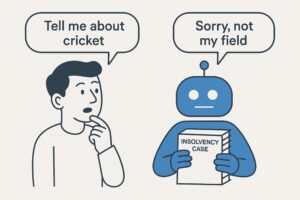In the early 2000s, the Nokia 3310, affectionately known as ‘the brick’, was the epitome of mobile technology. This sturdy, reliable device could make calls, send texts, play Snake, and wake you up with its trusty alarm clock. For many of us, the Nokia 3310 was the first taste of mobile freedom, and we were content with its limited capabilities. But as technology advanced, so did our expectations and needs. Enter the era of smartphones – versatile, multifunctional devices that revolutionised our daily lives. Today, we’re witnessing a similar evolution in the realm of artificial intelligence (‘AI’). The question is, do you want to stay with the brick, or embrace the transformative power of generative AI?
The Nokia 3310 – A Blast from the Past
Let’s take a nostalgic trip down memory lane. The Nokia 3310 was a marvel of its time. It could:
- Make Calls and Send Texts: Communication was straightforward and reliable.
- Play Snake: Hours of entertainment were at your fingertips.
- Set Alarms: The trusty alarm clock ensured you never missed a meeting or class.
These features were groundbreaking at the time, and we were perfectly happy with what the 3310 could offer. It was simple, durable, and did exactly what we needed it to do – no more, no less.
The Evolution of Mobile Phones
Fast forward to the present, and mobile phones have undergone a dramatic transformation. The introduction of smartphones revolutionised the way we interact with technology and the world around us. Modern smartphones can:
- Browse the Internet: Access information and services from anywhere.
- Engage in Social Media: Stay connected with friends and family across the globe.
- Utilise GPS: Navigate to any destination with ease.
- Manage Banking: Handle financial transactions securely and conveniently.
- Run Apps: Perform a myriad of tasks, from fitness tracking to project management.
- Use Smart Assistants: Get personalised help from AI-powered assistants like Siri and Google Assistant.
- Access Work and Private Emails: Seamlessly manage both work and personal communications on the go… and more
The transition from basic mobile phones to smartphones illustrates how advancements in technology can dramatically enhance our capabilities and convenience. We moved from being content with basic functions to embracing a world of limitless possibilities. Can you imagine not having access to work and private emails on your phone now? This will be the same with generative AI sooner than you think.
Older AI – The Task-Specific Tools
Just as the Nokia 3310 was designed for specific tasks with limited adaptability, older AI systems were built to handle basic, predefined functions. Examples of older AI applications include:
- Basic Data Processing: Handling simple calculations and data entries.
- Simple Automation: Performing repetitive tasks based on set rules.
- Predefined Responses: Responding to queries with scripted answers.
While these older AI systems served their purpose, they were constrained by their task-specific nature. They lacked the flexibility and adaptability needed to handle complex, dynamic situations.
Generative AI – The Versatile, Multifunctional Systems
Enter generative AI, the modern equivalent of smartphones in the AI world. Generative AI systems, like VAi, are versatile and multifunctional, capable of handling a wide range of tasks with remarkable flexibility. Here’s how generative AI compares to older AI:
- Predictive Text vs. Smart Assistants: Older AI could predict text inputs based on common patterns. Generative AI, on the other hand, powers smart assistants that understand context, learn from interactions, and provide personalised recommendations.
- Automated Content Creation: Generative AI can create high-quality content, from written articles to even artwork and music, by learning from vast datasets and mimicking human creativity.
- Advanced Data Analysis: Generative AI can analyse complex datasets, identify patterns, and generate insights that drive better, more informed, decision-making.
- Personalised Recommendations: By learning from user preferences and behaviours, generative AI can offer tailored suggestions, enhancing user experience.
The Benefits of Generative AI’s Adaptability and Learning Capabilities
Generative AI’s ability to learn and adapt sets it apart from older AI systems. Here are some key benefits:
- Increased Efficiency: Automating complex tasks and processes, freeing up time for more strategic activities.
- Better Decision-Making: Providing deeper insights and data-driven recommendations.
- Personalised Experiences: Tailoring interactions and services to individual needs and preferences. No more generic ‘support’ – if it really was support!
Overcoming Initial Skepticism and Embracing AI
Remember how we were content with the Nokia 3310’s basic features? Similarly, some people today might be comfortable with traditional automation tools and older AI systems. However, just as we eventually embraced smartphones for their multitude of benefits, it’s time to consider the transformative potential of generative AI.
A Playful Challenge: Do You Want to Stay with the Brick?
Imagine still using a Nokia 3310 today. Sure, it makes calls and sends texts, but would you be satisfied with that when smartphones offer so much more? Here’s a playful comparison to challenge your perspective:
- Communication:
- Nokia 3310: Simple calls and texts.
- Smartphones: Video calls, instant messaging, social media, and more.
- Entertainment:
- Nokia 3310: Snake.
- Smartphones: Streaming services, music, gaming apps, multimedia experiences.
- Productivity:
- Nokia 3310: Basic alarm clock.
- Smartphones: Calendar management, to-do lists, productivity apps.
- Information Access:
- Nokia 3310: Limited.
- Smartphones: Internet browsing, real-time updates, news apps.
- Email Management:
- Nokia 3310: Non-existent.
- Smartphones: Seamless access to work and private emails, enabling constant connectivity.
The same logic applies to AI. Do you want to stick with older, limited AI tools, or embrace the expansive capabilities of generative AI? By integrating generative AI into your workflows, you can unlock new levels of efficiency, creativity, and personalisation.
Conclusion
The journey from the Nokia 3310 to modern smartphones will mirror the evolution that’s happening now from older AI to generative AI. Just as smartphones revolutionised our daily lives, generative AI will transform the way we work and interact with technology, and in doing that change the way we live our lives, both at play and at work. Very much as you didn’t settle for the ‘brick’, you will move up through the gears over time – albeit at your own pace – until you experience the full versatility and power of generative AI. It’s inevitable, it’s just a series of baby steps, very much like your regular upgrading of your mobile phone between the 3310 and your current one.






